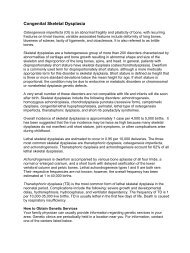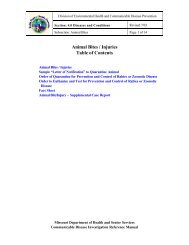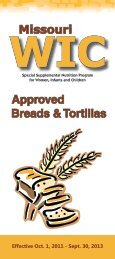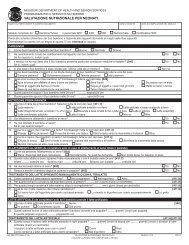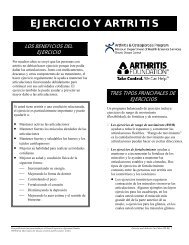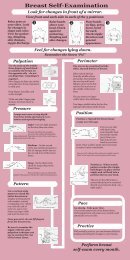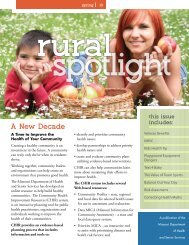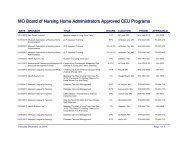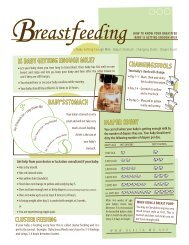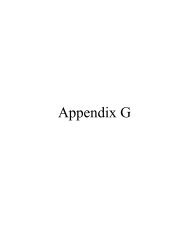Prevention and Control of Communicable Diseases - Missouri ...
Prevention and Control of Communicable Diseases - Missouri ...
Prevention and Control of Communicable Diseases - Missouri ...
Create successful ePaper yourself
Turn your PDF publications into a flip-book with our unique Google optimized e-Paper software.
FOOD SAFETY IN CHILDCARE SETTINGS AND SCHOOLS<br />
July 2011<br />
- Clean all surfaces before beginning food preparation. Unclean surfaces can harbor bacteria <strong>and</strong><br />
contribute to cross contamination. Cross contamination occurs when a contaminated product or its<br />
juices contacts other products <strong>and</strong> contaminates them.<br />
- Use an approved sanitizer for food contact surfaces. Test kits can be used to check the<br />
concentration. High concentration <strong>of</strong> sanitizer can leave high residuals on the food contact<br />
surface, which can contaminate food, make people ill, <strong>and</strong> damage surfaces or equipment.<br />
- Label all sanitizer spray bottles. Check sanitizer solution daily using a test kit. Make a fresh<br />
solution if the concentration is below acceptable levels. This will prevent accidental misuse <strong>of</strong><br />
sanitizer spray bottles.<br />
- Always wash h<strong>and</strong>s, cutting boards, utensils, <strong>and</strong> dishes between different foods. Use separate<br />
cutting boards for raw meats <strong>and</strong> produce. Cross contamination occurs when a contaminated<br />
product or its juices, (e.g., raw meat or poultry) touches other products (e.g., fresh fruit, vegetables,<br />
cooked foods) <strong>and</strong> contaminates them.<br />
- Thaw foods properly: 1) on a tray on the bottom shelf <strong>of</strong> the refrigerator, 2) under<br />
continuously running cold (70° F or less) water in continuously draining sink, or 3) in the<br />
microwave, only if the food is cooked immediately afterwards. DO NOT leave food out on the<br />
kitchen counter to thaw. Thawing food on a kitchen counter can allow bacteria to grow in the<br />
food.<br />
- DO NOT prepare infant formula in the h<strong>and</strong>washing sink area in the infant room. Use water<br />
from kitchen prep sink to mix infant formula or use bottled water.<br />
� Cooking guidelines/rationale<br />
- Use a trained, certified food h<strong>and</strong>ler to prepare food. Staff knowledgeable about safe food<br />
h<strong>and</strong>ling practices can prevent foodborne illnesses. Health departments may require certifications<br />
for commercial facilities.<br />
- Rapidly heat potentially hazardous food. Take food temperatures to make sure food has<br />
reached appropriate temperature. Check with your local public health agency for<br />
appropriate temperatures. Rapid cooking kills bacteria that may cause illness.<br />
- Cook raw hamburger thoroughly. Use a food thermometer to achieve an internal<br />
temperature <strong>of</strong> 155° F for 15 seconds. Raw or partially cooked ground beef can be contaminated<br />
with E. coli O157:H7. Large quantities <strong>of</strong> hamburger may “look” cooked, but may contain<br />
“pockets” <strong>of</strong> partially cooked meat.<br />
- Once cooked, take food temperatures to make sure food has reached appropriate<br />
temperature. Check with your local public health agency for appropriate temperatures.<br />
Monitoring temperatures can ensure that all potentially hazardous foods have not been in the<br />
“danger zone” (41° - 135° F) too long, which allows for bacterial growth.<br />
- DO NOT put cooked food in the same container or on the same unwashed container, platter,<br />
or cutting board that was used for uncooked meat or poultry. The container or platter could<br />
contain harmful bacteria that could contaminate the cooked food.<br />
- DO NOT serve unpasteurized milk, cheese, or apple juice. These items may be the source <strong>of</strong><br />
foodborne illnesses caused by pathogens such as Campylobacter, Salmonella, E. coli O157:H7, <strong>and</strong><br />
Listeria.<br />
48



